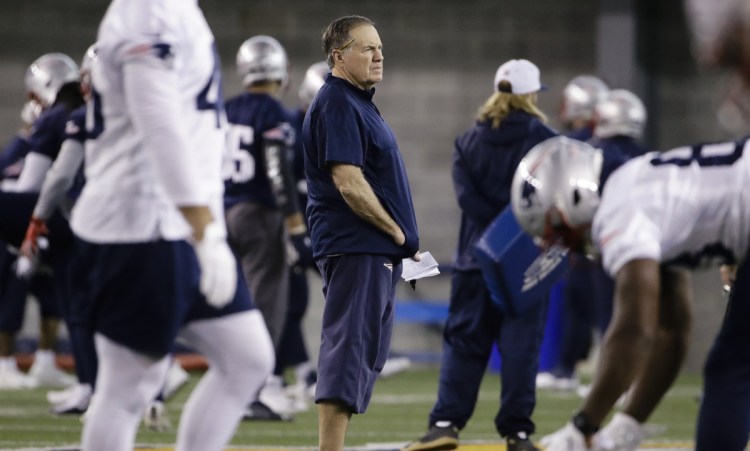Daniel Jeremiah knows basically everything there is to know about the NFL draft.
Including this: Anything goes with Bill Belichick running the show.
“Yeah, predicting what the Patriots are going to do is impossible,” said Jeremiah, the lead draft analyst at The NFL Network. “I’ve been trying it on the media side for six years, and it’s tough to do.”
Two years ago the New England Patriots traded virtually all their picks for veterans. Last year they took a running back in the first round, a rare move for any team, and bypassed the option to nab a quarterback of the future. They constantly engage in trade talks, always looking to add picks and increase their odds of hitting on one.
Consider the 2015 draft: They took two defensive ends within four picks – Oklahoma’s Geneo Grissom at No. 97 and Arkansas’ Trey Flowers at No. 101 (a pick acquired in the Logan Mankins trade).
One ended up becoming a centerpiece of the front seven. The other couldn’t get on the field on defense. The draft, as we’ve all learned over the years, is a mess. Everybody misses. It’s inevitable.
But owner Robert Kraft once called the draft the “lifeblood” of NFL success, and he’s not wrong. Although the Patriots hold the trump cards in Belichick and Tom Brady, they still need an adequate supporting cast.

Running backs are seldom taken in the first round, but Sony Michel, chosen at No. 32 overall last year by New England, proved to be a great pick for the Patriots. Associated Press/Charles Krupa
And this spring, the Pats have a tremendous opportunity to position themselves for sustained success into the 2020s. They enter the 2019 draft with six picks in the top three rounds. They can, potentially, add several young centerpieces to go along with Sony Michel and J.C. Jackson, two high-level contributors who will be playing on affordable contracts for the next several seasons.
The Super Bowl champs could use an infusion of youth.
The process of identifying the next batch of Patriots began last year for the scouting department, and it continues this week in Indianapolis at the league’s annual scouting combine. Prospects are measured from every angle. Bizarre questions are commonplace as teams meet with players in speed-dating sessions. Draft strategy crystallizes for each franchise.
The Patriots will begin deciding how they’ll approach a critical offseason.
After final cuts this past summer, the Pats had the third-oldest roster in the NFL, according to PhillyVoice.com. That number has been creeping up each year. Since 2014, the Patriots have gone from 11th to 13th to 15th to 26th to 30th in average age on the 53-man roster, per the same data.
The drafts in 2009-12 carried the Patriots through the better part of a decade, netting multiyear starters and in some cases cornerstone players such as Julian Edelman, Patrick Chung, Rob Gronkowski, Devin McCourty, Nate Solder, Marcus Cannon, Chandler Jones and Dont’a Hightower. All those players are nearing the ends of their careers (and a few have already left New England). Their salaries have escalated. And too many bloated veteran cap hits will cause issues in the not-so-distant future.
It’s not that the Patriots haven’t drafted other difference-makers since then; Flowers, Shaq Mason, Joe Thuney and Michel fit that description.
But they’re still searching for a home-run draft class.
“Who is their core?” Jeremiah said last summer. “Who is their young core that you’re going to build around going into the future? The crazy thing is, you look at (Jacoby) Brissett and (Jimmy) Garoppolo, obviously could have been the captain of that ship in terms of core. … But they don’t have that.”
For the second consecutive offseason, any discussion regarding the Patriots’ draft strategy begins with the search for Tom Brady’s successor. On a Monday conference call, Jeremiah mentioned Duke’s Daniel Jones as a quarterback who would “make a lot of sense” for the Patriots at No. 32.
“He’s very bright,” Jeremiah said. “He’s going to be able to kind of swallow the information you’re going to have to swallow in that offense in due time.”
Jeremiah also brought up N.C. State quarterback Ryan Finley as a mid-round option for the Pats. He compared Finley to Jared Goff.
Jeremiah also sees the Patriots targeting a tight end high in the draft. He declared this the “best tight end class” he’s seen in years, lofty praise considering the 2017 class included George Kittle, O.J. Howard, David Njoku, and Evan Engram.
Iowa’s T.J. Hockenson is the “safest player in the draft,” Jeremiah said.
“I (evaluated) him the day after watching Rob Gronkowski live in person in the playoff game against the Chargers, and I saw Gronk completely dominate a football game without really having to catch the ball,” Jeremiah said. “He was just so dominant in the run game. And then I flip on this kid. … I saw this kid with that same temperament and nastiness in the run game and controlling the run game, and then on top of that, he does nothing but get open and catch everything they throw to him.”
The Pats would need to trade up for Hockenson, which isn’t out of the question considering their draft capital. Then there’s Hockenson’s teammate, Noah Fantz, and Alabama’s Irv Smith. Both could be in play at the end of round one.
And there are several other positions of need that the Patriots may address early: Offensive tackle (Cannon is 30, Trent Brown is a free agent, Isaiah Wynn is coming off a season-ending Achilles injury); wide receiver (Edelman is the only notable player under contract); any player along the defensive line; a strong safety to eventually assume the crucial role occupied by Chung.
The Patriots’ 2018 draft class shows promise. An even deeper 2019 class, a realistic expectation given such an abundance of picks, will keep them flourishing into the next decade.
Send questions/comments to the editors.


